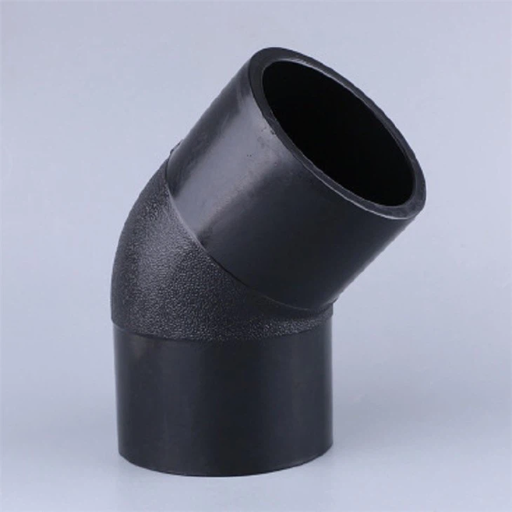Plumbing and construction are incomplete without high-density polyethylene (HDPE) fittings. This article focuses on the specifics of HDPE butt fusion 45-degree elbow, a vital component often used to negotiate changes in direction in piping systems. Types of HDPE fittings are discussed, as well as the complexities of the butt fusion welding process and helpful tips for obtaining excellent results. As such, readers will be able to understand how these fittings operate, gain insight into their advantages, and learn practical installation methods. In order to ensure that precision and reliability are incorporated in any projects that use HDPE technology, this guide must capture a comprehensive understanding of how these fittings work, their benefits, and installation tips.
What is a Butt Fusion 45° Elbow?
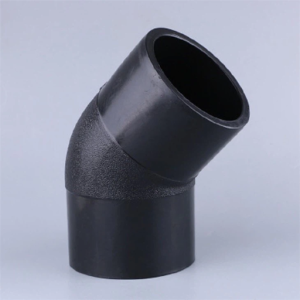
Image source: https://www.sdyostpipe.com/
A Butt Fusion 45° Elbow is a fitting with a 45-degree bend that is used to change the direction of flow in a pipe. This fitting is made from high-density polyethylene (HDPE) and joined using butt fusion welding, where the ends of both pipes, along with the fitting, are heated until they melt together into one piece. Various applications, including plumbing, industrial, and agricultural settings, place much value on this elbow type, enabling smooth flow and hence elongating service life while resisting corrosion or impact.
Definition of Butt Fusion
Butt fusion is a technique used in the welding of thermoplastic pipes and fittings mainly made of high-density polyethylene (HDPE). This involves aligning two ends to join them, heating them with a controlled source until they melt, and pressing them under pressure to form a robust and homogeneous bond. The strength of butt fusion is that it can create a watertight joint able to withstand high pressures and mechanical stresses, therefore it becomes an ideal choice for many applications such as water distribution systems and industrial uses. This process guarantees the overall integrity of the pipe system, thus ensuring long-lasting durability and increased reliability.
Understanding the 45 Degree Elbow in Pipe Systems
A 45-degree elbow is essential in piping systems because it allows for a smooth change in direction and, hence, efficient flow without turbulence. Typically, this fitting is employed where there is a need to effect moderate changes in directions, thus making it suitable for use in drainage lines, irrigation purposes, or even plumbing applications. To ensure compatibility with the existing piping system, considerations like material type (often HDPE), diameter, and connection method must be made when choosing a 45-degree elbow. Using appropriate elbow fittings maximizes the flow while minimizing risks related to pressure loss or leakages, which eventually enhances its overall effectiveness and lifespan within the pipe network.
Why Use HDPE for Butt Fusion?
When it comes to butt fusion, high-density polyethylene (HDPE) is widely considered an excellent choice because of its outstanding strength-to-weight ratio resulting in solid joints that can sustain pressures. This means that if used for residential plumbing or industrial applications, HDPE will serve longer than others since HDPE doesn’t corrode and is resistant to most chemicals. In addition, the process fuses the two parts, like ironing them, such as making them airtight and not leakproof; this minimizes leakages, which are critical to system integrity. Moreover, lightweight HDPE makes it easy to handle it during installation, thus reducing labor costs. It also has different fittings and pipe systems, enhancing its use in varying fields.
How to Properly Install a HDPE 45-Degree Elbow?
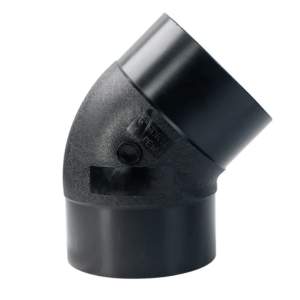
Start by measuring and marking off the sections of pipes where the 45-degree HDPE elbow shall be placed. The ends of the bending part and pipes should be cut cleanly using a tube cutter. Then, ensure that all surfaces are free from dirt and other particles so that they get connected very well. Set it at your preferred angle, then insert each pipe end into the socket on fitting. Melt these areas using heat from appropriate fusion equipment specified by the manufacturer’s manual. Once materials have been heated sufficiently, press them firmly together. As soon as they have cooled down enough for hardening, release this grip, leaving a solid joint between material pieces. Finally, examine any spaces or imbalanced points in this connection so that we know if sealing is okay.
Required Equipment and Tools for Butt Fusion
To effectively fuse high-density polyethylene pipes using butt fusion, several essential tools and equipment are needed:
- Fusion Machine: It’s a controlled heating device that provides the required temperature to allow the surfaces of the pipe and fitting to melt. It has a heating plate and clamps that hold the pipes in position during fusion.
- Pipe Cutter: This is a sharp tool used to precisely cut HDPE pipes with clean and straight edges, ensuring secure jointing.
- Alignment Tool: This tool accurately aligns pipe sections when fusing them so they fit properly into an elbow or other fittings.
- Temperature Measurement Device: It is necessary to monitor surface temperatures on both the pipe and fitting while being heated throughout the process of heating. These may include digital thermometers or infrared laser thermometers.
- Safety Gear: While performing the heat fusion process, it is essential to use protective eyewear and gloves.
With appropriate equipment, a strong fused joint that will last according to industry standards can be achieved.
Step-by-Step Procedure for Installing the Elbow
- Before starting: ensure all tools and equipments are gathered while ensuring cleanliness of the work area. Examine HDPE pipes and fittings for any impairment or contaminants hindering a successful fusion process.
- Cutting Pipes: Use a pipe cutter to trim the edges of HDPE pipes so they are neat and straight. This step is vital for attaining a good fusion joint.
- Alignment: Position an elbow fitting at the required angle, then utilize an alignment tool to check if sections of pipe properly line up with one another. This acts as a precision stage when fusing occurs.
- Heating: Slide prepared end portions of pipe together with an elbow fitting into the fusion machine, setting the machine at the correct temperature according to the manufacturer’s specifications for HDPE fusion. Let the surfaces get warmed until they reach the recommended melting point.
- Joining Pieces Together: Once you’re done with prepping, remove the heater plate and quickly press the heated pipe surfaces and elbow fittings together, making sure they remain in firm contact until they’re cooled and solidified.
- Inspection: After the joint cools down, inspect for gaps or misalignments. A proper seal is critical for preventing leaks and ensuring the integrity of the piping system.
- Final touches: If approved, tape or insulate the joint as needed and clean up to complete the installation work area.
Following this guide, you can install an elbow correctly and securely, meeting all relevant industry standards.
Common Mistakes to Avoid During Welding
- Inadequate Readiness: Insufficient surface preparation is common. Before welding, the surfaces must be free of contaminants such as dirt, rust, or oil. Failure to do so can result in weak welds and poor adhesion.
- Wrong Settings: Each welding machine has its settings for various materials and thicknesses. A standard error is an incorrect voltage or amperage, which may lead to problems like a burn–through or inadequate penetration.
- Flawed Method: Most welders make this mistake using the wrong techniques, such as incorrect torch angle, travel speed, or inconsistent motion. It can influence the quality of the welds, resulting in flaws like undercuts, porosity, or uneven beads.
- Failure to Follow Safety Precautions: Lack of proper personal protective equipment (PPE) or failure to adhere to safety procedures could cause accidents or injuries. You must always have adequate tools and be aware of your work surroundings.
- Overlooking After-Weld Inspection: Once you finish welding a joint, it is important to inspect it for any weaknesses. This step should not be skipped because some issues may remain that can jeopardize the whole project’s integrity.
This knowledge about common errors helps improve the skills of welding workers so they can do better work in the future.
What are the Advantages of Butt Fusion Fittings?
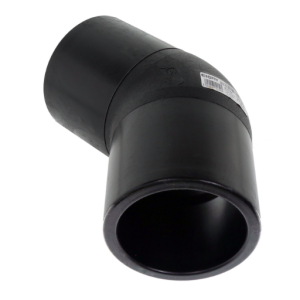
There are several distinct advantages associated with butt fusion fittings in piping systems. First and foremost, they create a robust, smooth joint that improves flow efficiency and minimizes the risk of leaks. This process also guarantees that pipes have homogenous material properties and thus can resist pressure and temperature inconsistencies. Again, this type of joining can be done in different environments, therefore it is applicable for both burying underground or keeping aboveground piping systems. Moreover, the time required for the installation process is generally shorter, which may translate into decreased workforce-related expenses and reduced project timelines. Eventually, butt fusion fittings aid in making pipe systems solid and reliable.
Durability and Strength of HDPE Fittings
HDPE (High-Density Polyethylene) fittings have earned a reputation as being among the most durable and strong ones available on the market today; this makes them suitable for use across various fields. These fitments have superior resistance to impact forces, corrosion effects, and chemical attacks, thereby serving for extended periods, unlike traditional materials like iron or PVC tubes. The ability of HDPE to withstand extreme temperatures (ranging from -40°F to 140°F) further enhances their suitability for challenging environments. Consequently, these products are light but hardy, enabling easier handling and fitting processes without losing strength. Also, leakage joints ensure there will be no sudden failures even under high-pressure conditions; hence, they are highly employed in industrial areas or municipality networks worldwide.
Cost-Effectiveness of Butt Fusion 45 Degree Elbow
The installation process and the long-term performance of pipe systems both show how cost-effective butt fusion 45-degree elbows are. These fittings do not need additional components as their fusion creates a continuous joint that does not require gaskets or other sealing materials, thus reducing upfront costs. Furthermore, this makes it an economical choice for projects given the fast installation rates that are associated with butt fusion techniques which reduce labor costs. Regarding durability, HDPE fittings protect against corrosive damage and hazardous chemicals, thereby decreasing frequent replacement or repairs over time. Thus, purchasing such items will save money in the long run instead of spending more on regular maintenance later; hence, they are used in various sectors, including municipal and industrial applications.
Compatibility with HDPE Pipe Systems
HDPE fittings, especially butt fusion 45-degree elbow designs, blend seamlessly with HDPE pipe systems which makes them highly compatible for use in various contexts. The homogenous bond created by the fusion process between HDPE pipes and fittings ensures the joint is as strong as the pipe. Additionally, HDPE pipes of several sizes and with different wall thicknesses exist to meet varying installation needs. Also, these HDPE systems can resist multiple types of chemicals, thereby improving their use in various waters and industries involving manufacturing processes, among others. This enhances its robustness and maintains its overall effectiveness when performing tasks connected with fluid transmission activities within industrial setups such as factories. Propriety installation procedures abiding by industry codes enhance compatibility between pipe systems and HPDE fitting for ideal long-term performance and dependability.
What Maintenance is Required for Butt Fusion 45-Degree Elbow?
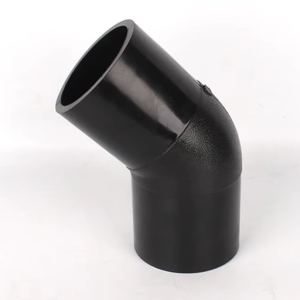
Maintenance of butt fusion 45-degree elbows is relatively minimal due to the durable nature of HDPE materials; nevertheless, routine checks should be carried out to determine any signs of wear, strain, or environmental damage, especially in highly pressurized and hot systems. It is crucial to ascertain that all joints are unbroken and without leaks. Similarly, debris or clogs must be eliminated instantly to maintain optimal flow rates. If any faults surface, they must be rectified immediately, which could escalate into more severe issues later. On the whole, proper installation guidelines, together with industry regulations, significantly reduce maintenance requirements.
Quality Matters: How to Choose the Best HDPE Fittings
When choosing the right HDPE fittings for your project, you should consider several critical factors based on insights from top industry sources. First, check whether the fittings meet relevant industry standards and certifications such as those set by ASTM (American Society for Testing and Materials) or ISO (International Organization for Standardization). Second, verify if they are compatible with specific HDPE pipe sizes and applications being worked on, including pressure ratings and chemical resistance properties. Finally, find out about the manufacturer’s reputation; this can significantly affect their performance and lifespan within a piping system whose fittings have been sourced from a materials supplier known for its quality items that last longer than average. In addition, the ease of installation should also be considered alongside technical support from suppliers regarding best practices or during troubleshooting.
Routine Inspections and Common Issues
Regular inspections must be performed to maintain the integrity of HDPE piping systems. Such check-ups should seek signs of wearing off, misalignment, and any visible damage, particularly at joints and connections. Other problems that can arise during these inspections are leaks, often indicated by visible moisture or erosion near the joints, and blockages due to debris accumulation. Changes in flow rates should also be monitored closely for early problem detection. These issues should be addressed promptly to extend the system’s service life and ensure it performs optimally with maximum efficiency. Also, such an inspection should consider manufacturer guidelines and industry best practices.
Repair Techniques for HDPE Pipe Fittings
Repairing HDPE pipe fittings requires specific techniques that guarantee a reliable and durable fix. Common methods include:
- Heat Fusion: This method involves melting the surfaces of HDPE pipe and fitting using a heating element. Then, they are pressed together until they cool and solidify, creating a watertight bond between them. It is considered one of the most effective ways of repairing or installing new pipes.
- Electrofusion: In this case, an electric current heats a fitting, causing pipe/fitting surfaces to melt, resulting in a strong bond between them when cooled down again. It is mainly used when making joint repairs since traditional welding is sometimes challenging.
- Mechanical Repairs: Methods other than fusion, like clamping or coupling, can help repair damaged areas where fusion cannot work. These rely on high-strength fittings that will withstand pressure while providing good sealing between broken parts of pipes.
- Patch Repairs: For smaller defects or leaks, short-term solutions can involve patching using HDPE adhesive patches/wraps. Such materials are designed for durability before lasting repairs are done, hence suitable for immediate remedies whenever needed.
Which repair technique to use depends upon factors such as the extent of damage, the location of the fitting point, and equipment availability. Hence, proper evaluation and adherence to the manufacturer’s guidelines are essential if HDPE piping systems last long and function properly.
Reference sources
-
45 Degree Elbows IPS DR11 – Black HDPE Butt Fusion
This source provides detailed information on various sizes and specifications of HDPE butt fusion 45-degree elbows, suitable for multiple applications.
Read more -
Butt Fusion 45deg Elbow 1″ IPS, DR11
This product page discusses the use of molded butt fusion 45-degree elbows for water, sewer, gas, geothermal, and other industrial applications.
Read more -
3″ IPS 45 Degree Elbow HDPE Butt DR11
This source provides specifications for a 3″ IPS HDPE molded butt fusion 45-degree elbow, including pressure ratings and material details.
Read more
Related Articles: Essential Attributes of Butt Fusion 45° Elbow



